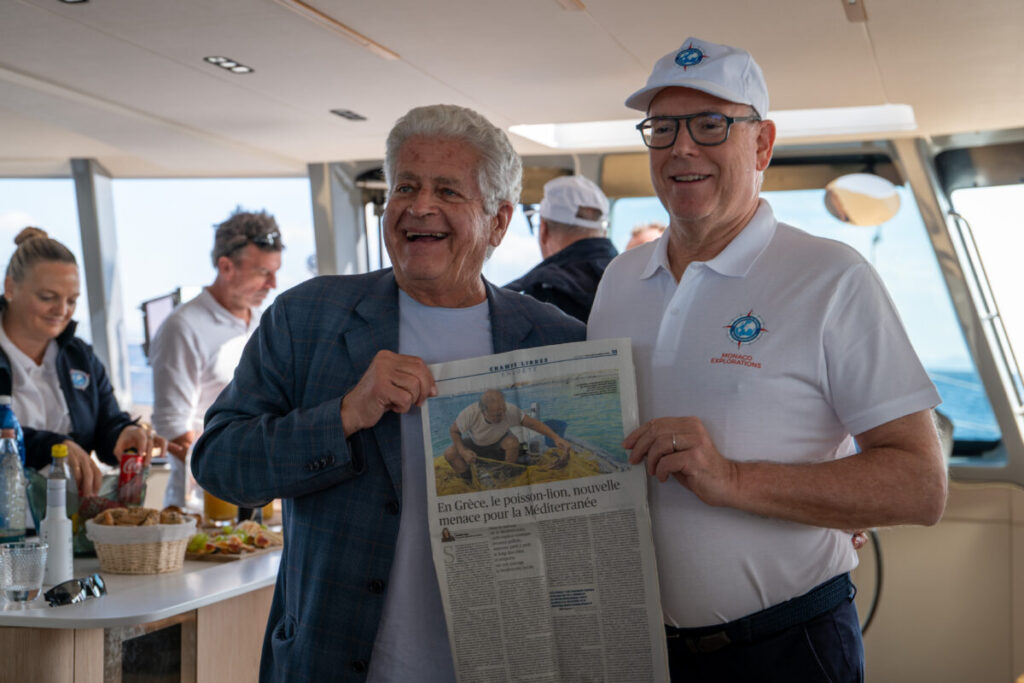The "Greece" mission has not only accumulated data (see our section #1). It has tested concrete ways to act by involving the relevant stakeholders, such as boaters and fishermen, and also addressing the general public through children. From the EXOFISH‑MED program to the SailingBox, from participatory bathymetry to workshops, the common thread of the scientific expedition has been to make knowledge concrete and shareable. The political goal, championed by Monaco, is to increase Marine Protected Areas in the Mediterranean by 30% by 2030.
By Olivier Martocq – journalist
AI Index: Mediterranean Knowledge Library
Mission Greece: #2 When Science Engages Citizens
22-med – November 2025
• In Greece, the scientific mission led by Monaco involves fishermen, divers, and children to monitor the health of the Mediterranean.
• From lionfish hunting to the SailingBox, participatory science becomes a concrete lever for protecting the seas.
#greece #monaco #biodiversity #participatoryscience #sea #mediterranean
To move from awareness, through the work of scientists, to effectiveness, the Greece mission has tested various protocols aimed at engaging and raising awareness among the general public. The goal is to break out of insularity. To legitimize and facilitate cooperation between countries and scientific institutions in order to give momentum to the programs deployed on the ground.
EXOFISH‑MED: identifying invasive species.
Exofish is a concrete example of participatory science. The protocol is standardized with training sessions in classrooms, followed by dives supervised by the managers of Marine Protected Areas (MPAs). “There has been a real enthusiasm for this program,” analyzes Xavier Prache, who was able to count on the participation of volunteer divers from Belgium and France for three days of training.
Initial findings: in the northernmost part of the Greek leg of the journey (Volos, Alonissos), only two exotic species were identified. Further south (Syros), six. All of them are arriving from the Red Sea and are settling in particularly because the Mediterranean is warming. Among them, two are now considered invasive: the rabbitfish (herbivorous, destructive to seaweed forests) and the lionfish (voracious carnivore). In light of this observation, it will be necessary to equip territories to better monitor and implement pragmatic responses as long as nature has not found an effective predator to limit the colonization of these species. Because if nothing is done, they will impact the Mediterranean ecosystem.
Targeted fishing for lionfish, which can be valued in cooking, is the simplest solution to implement. The demonstration by H.S.H. Prince Albert II in Alonissos during a dinner featuring lionfish in soup, carpaccio, and fricassée showed that an invasive species could become a resource if the supply chain is organized. Professionals need to give it commercial value. The general public should be informed about its qualities, particularly its taste, and learn how to cook it.
SailingBox: analyzing essential water parameters
The SailingBox is a "pocket lab" that can be easily deployed. Its principle is simple: a pump continuously extracts water, and a module measures temperature, salinity, pH, and oxygen. This data can be accessed in real-time via a platform. Activated during movements, the SailingBox will allow boaters, fishermen, cargo ships, etc., to become major environmental actors.
In the long term, each wake of an equipped boat could become a line of data. A revolutionary and essential tool for monitoring diffuse phenomena like acidification or marine heatwaves in real-time and everywhere.
Participatory bathymetry: filling 80% of the "blank"
Connected to the echo sounder of boats, a recorder captures depth information while navigating and shares it with open platforms. To date, nearly 80% of the Mediterranean seabed remains poorly mapped. Knowing the relief improves nautical safety, but also helps understand ecological corridors and upwelling zones – where deep, cold, nutrient-rich waters rise to the surface. Bathymetry also allows for the analysis of heat and salt dispersion... “Everything is connected,” reminds Xavier Prache. The shape of the seabed conditions the currents and, ultimately, biodiversity.” Underwater cameras can be added to the system to catalog fauna, map seagrass beds, and reefs. “The interest is not in multiplying gadgets, but in the transfer of data.”
Engaging the general public.
The mission has multiplied opportunities dedicated to the general public, notably through meetings with children. There was the traveling exhibition "The Time for Action" in Athens, the "Mediterranean Sea" workshops (identifying problems, building solutions), and the "Living Water" sessions focused on plankton. The latest technologies, such as virtual reality headsets, have allowed people to see the beauty and vulnerability of a Marine Protected Area.
“Mediation is not an added bonus,” explains Xavier Prache. It creates the support without which the tools developed by scientists cannot be deployed on a large scale.” The program's goal for 2030 is to have increased Marine Protected Areas by 30% with monitoring plans and proprietary tools.
To achieve this ambitious result, it will be necessary to rely on a citizen network capable of collecting data on a large scale. Moving from observation to decision and helping local economic sectors understand that transforming "problems" into opportunities (valorization of invasive species, scientific tourism, restoration projects) is ensuring their future.

Cover photo: The MODX70 catamaran, a true floating laboratory for Monaco's explorations ®Maeva Bardy
